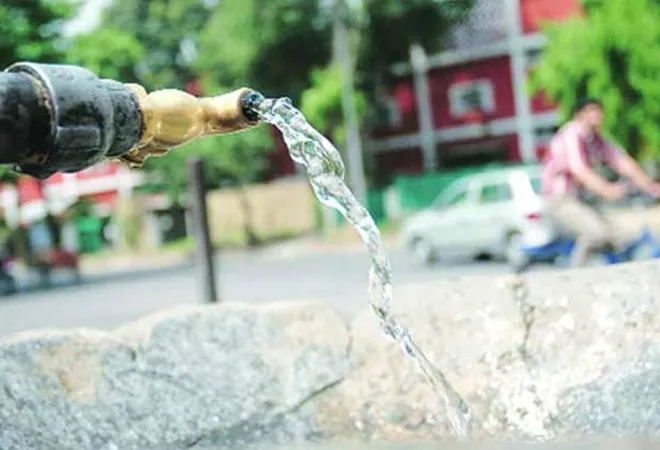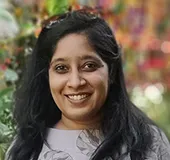-
CENTRES
Progammes & Centres
Location

Mumbai, run by India’s richest municipal corporation that aims to compete with internationally benchmarked governance practices, has repeatedly struggled for a basic need—water. Despite careful planning for decades to meet the needs of a rapidly increasing population, Mumbai has perennially faced water shortages. Presently, against the demand of 4,200 million litres per day (MLD), Mumbai gets 3,950 MLD. In addition to this shortfall of 250 MLD, inequitable distribution and intermittent supply add to the city’s water stress. In the past few years, Mumbai has faced water cuts of up to 10-15 percent due to delayed monsoons.
Mumbai draws its water from seven lakes in the city and the neighbouring districts of Thane and Palghar, with a total drawing capacity of 4,128 MLD. The supply is calculated considering Mumbai's slums receive 45 litres per capita per day (lpcd) of water; residential buildings receive 135 lpcd, and chawls (residential buildings with common community toilets) and residential buildings with sewage treatment plants receive 90 lpcd.
Under its “Water for All” policy implemented in May 2022, the Brihanmumbai Municipal Corporation (BMC) has begun supplying 3,950 MLD to provide water connections to unmapped slum clusters in the city, hitherto lacking essential civic services.
The potable water supply to Mumbai has increased by 16.17 percent since 2014, from 3,400 MLD to 3,750 MLD after 2014, 3,850 MLD after 2018, and 3,950 MLD in 2023. The demand for potable water will increase in the next two decades, straining the existing water sources. According to official projections, Mumbai will need 5,320 MLD or 34.6 percent more water by 2031 and 6,424 MLD or 62.6 percent more water by 2041, attributed mainly to the conversion of more slums and chawls to residential buildings through the state government’s Slum Rehabilitation Scheme, enhanced floor space index (FSI) resulting in a proliferation of high-rise buildings, and increased migration and floating population. Under its “Water for All” policy implemented in May 2022, the Brihanmumbai Municipal Corporation (BMC) has begun supplying 3,950 MLD to provide water connections to unmapped slum clusters in the city, hitherto lacking essential civic services.
Bridging the widening demand-supply gap
BMC has primarily focused on addressing the growing demand by adding more water to the city’s stock by creating new water sources with capital-intensive infrastructure. On the other hand, measures on the supply side of the system—such as fixing leakages to reduce non-revenue water, metering and billing, and staggered pricing linked to usage—appear to be given secondary importance. Top BMC bureaucrats have repeatedly spoken about the civic body’s commitment to creating new water sources “to resolve Mumbai’s water crisis”, indicating its priorities.
In 2016, then Chief Minister of Maharashtra, Devendra Fadnavis, formed a committee of experts to prepare a roadmap for equitable and 24x7 water supply to Mumbai. In 2018, the committee submitted a comprehensive report named “Toward Equitable and 24x7 Water Supply for Greater Mumbai”, listing long- and short-term measures, suggesting both demand- and supply-side measures with equal urgency.
Besides the high costs, measures that create new water sources come with other riders. BMC has proposed Gargai and Pinjal dams in Palghar to fetch 440 MLD and 865 MLD water, respectively. It has also proposed to link the Damanganga river basin in Gujarat to the proposed Pinjal reservoir to add another 1,586 MLD. Speaking to this author, senior BMC officials said that Gargai and Pinjal dams would require uprooting approximately 300,000 trees.
Wary of the public reception to consuming recycled wastewater—termed the ‘Yuck factor’ by the World Economic Forum—BMC had earlier earmarked its use for non-potable purposes.
BMC has also proposed an INR 1,600 crore desalination plant to add 200 MLD to Mumbai's supply, expandable to 400 MLD. However, experts and official reports have earlier opined that a desalination plant for Mumbai should be considered a last resort and an extreme measure, considering its high commissioning, operation, and maintenance costs.
Furthermore, INR 27,309 crore plans for tertiary sewage treatment at the existing seven sewage treatment plants are in the pipeline, adding 2,464 MLD to Mumbai’s water supply. This plan has highlighted the urgency to create a master plan for utilising this treated water. Wary of the public reception to consuming recycled wastewater—termed the ‘Yuck factor’ by the World Economic Forum—BMC had earlier earmarked its use for non-potable purposes. It had considered transporting the treated water from designated filling points across the city via tankers to bulk consumers. However, keen to emulate Singapore and Namibia’s NeWater and Direct Potable Reuse experience respectively, it has appointed a consultant to check the feasibility of potable use of recycled water and to integrate it with Mumbai’s existing water supply system.
Mumbai’s water distribution system has estimated non-revenue water (NRW)—water fed into the distribution system but failing to generate revenue—of 27 percent from leakages, theft, unmetered connections, and billing errors. The overall estimated NRW is 38 percent, including all unmetered consumption as of 2016—translated to a loss of 1,445 MLD, against the national norm of 15 percent. Interestingly, the Middle Vaitarna project, delivering 455 MLD, was commissioned in 2014 for INR 2,285 crore. Leaks in secondary transmission and distribution contribute to maximum losses, and there is an urgent need to fix these leakages. Bringing NRW down to the national norm of 15 percent can account for an additional 875 MLD without the need for any capital-intensive infrastructure. Significantly, it can ramp up BMC’s revenue from water charges from supply currently lost as NRW. Asset rehabilitation takes place annually, but BMC urgently needs to increase its pace. Allocation of funds towards network rehabilitation will be more prudent than heavy investments in supply augmentation infrastructure projects.
Mumbai’s water distribution system has estimated non-revenue water (NRW)—water fed into the distribution system but failing to generate revenue—of 27 percent from leakages, theft, unmetered connections, and billing errors.
Blurred focus on demand-side management
Given this scenario, BMC needs to focus urgently on demand-side management. The state government made rainwater harvesting mandatory for all buildings over 1,000 sq mt in 2002, but its implementation has remained sketchy. BMC’s Rainwater Harvesting Cell remains disempowered and fund-starved. Two large holding tanks at the flood-prone localities at Hindamata in Dadar and Parel in South Central and Central Mumbai are not used optimally. Though constructed to tackle localised monsoon-water logging with a capacity of holding 20 MLD floodwater for non-potable purposes with more planning, including the construction of water filling points for tankers, poor maintenance has seen a large quantum of the stored floodwater draining into the sea.
Another solution that has not been implemented in the city due to a lack of political will is universal water metering and meter restructuring for staggered billing, with a slab-wise hike in charges for usage beyond the normative demand of up to 200 lpcd in non-slums and 100 lpcd in slums. BMC had proposed volumetric meters attached to each flat instead of a single water meter for the entire building to bill individual flat-owners consuming water above the normative limit. But universal metering and meter restructuring have largely remained a paper exercise. Large-scale and dedicated public awareness campaigns are required to transform the culture of treating water as a free commodity into viewing it as a valued resource.
Conclusion
Time and again, the civic body has resolved water stress in Mumbai with a ‘fire-fighting’ outlook. These interventions have helped resolve the immediate problem but have brought the city back to square one with time. BMC must adopt a holistic approach to tackle the city’s water stress. Considering Mumbai’s development pace, creating new water sources as a supply-wide intervention cannot be dismissed as a solution to Mumbai’s water problem. The same commitment is needed to fix the demand-side challenges.
Eeshanpriya M.S. is an expert on governance and administration in Mumbai and Maharashtra, focusing on civic issues affecting India's commercial capital.
The views expressed above belong to the author(s). ORF research and analyses now available on Telegram! Click here to access our curated content — blogs, longforms and interviews.

Eeshanpriya M.S. is a writer and journalist with over eight years of experience reporting extensively on governance and administration in Mumbai and Maharashtra focusing on ...
Read More +